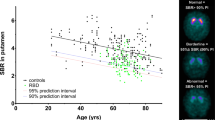Abstract
The nocturnal myoclonus syndrome (NMS) consists of stereotyped, repetitive jerks of the lower limbs that occur during sleep or wakefulness. NMS is often related with restless-legs syndrome (RLS) and can cause severe sleep disturbances and daytime sleepiness. The efficacy of dopamine agonists in the treatment points to a dopaminergic dysfunction in NMS. We investigated the central dopamine D2-receptor occupancy with [123I] labeled (S)-2-hydroxy-3-iodo-6-methoxy-([1-ethyl-2-pyrrolidinyl]methyl) benzamide (IBZM) (a highly selective CNS D2 dopamine receptor ligand) ([123I]IBZM) and single photon emission tomography (SPET) in 20 patients with NMS and in 10 healthy controls. In most of the patients with NMS there was a lower [123I]IBZM binding in the striatal structures compared to controls. The results indicate that NMS is related to a decrease of central D2-receptor occupancy.
Similar content being viewed by others
References
Akpinar S (1982) Treatment of restless-legs syndrome with levodopa plus benserazid. Arch Neurol 39:739
Ancoli-Israel S, Kripke DF, Klauber MR, Mason W, Fell R, Kaplan OJ (1991) Periodic limb movements in sleep in community dwelling elderly. Sleep 14:496–500
Bagetta G, DeSarro G, Priolo E, Nistico G (1988) Ventral tegmental area: site through which dopamine D2-receptor agonistslevoke behavioural and electrocortical sleep in rats. Br J Pharmacol 95:860–866
Brodeur C, Montplaisir J, Goudbout R, Marinier R (1988) Treatment of restless-legs syndrome and periodic movements during sleep withl-dopa. Neurology 38:1845–1848
Brücke T, Podreka I, Angelberger P, Wenger S, Topitz A, Kufferle B, Muller C, Deecke L (1991) Dopamine D2-receptor imaging with SPECT: Studies in different neuropsychiatric disorders. J Cereb Blood Flow Metab 11:220–228
Hudson JI, Hudson MS, Pliner LF, Goldenberg DL, Pope HG (1985) Fibromyalgia and major effective disorder: a controlled phenomenology and family history study. Am J Psychiatry 142:441–446
Innis RB, Malison RT, Al-Tikriti M, Hoffer PB, Sybirska EH, Seibyl JP, Zoghbi SS, Baldwin RM, Laruelle M, Smith EO, Charney DS, Heninger G, Elsworth JD, Roth RH (1992) Amphetamine-stimulated dopamine release competes in vivo for [123I]IBZM binding to the D2-receptor in nonhuman primates. Synapse 10:177–184
Lugaresi E, Cirignotta F, Coccagna G, Montagna P (1986) Nocturnal myoclonus and restless-legs syndrome. In: Fahn S, Marsden CD, Van Woert MH (eds) Myoclonus. Raven Press, New York (Advances in Neurology, Vol 43), pp 295–307
Montplaisir J, Godbout R, Boghen MD, deChamplain J, Young SN, Lappiere G (1985) Familial restless legs with periodic movements in sleep: Electrophysiologic, biochemical and pharmacologic study. Neurology 35:130–134
Montplaisir J, Godbout R, Poirier G, Bedard MA (1986) Restless-legs syndrome and periodic movements in sleep: Physiopathology and treatment with L-dopa. Clin Neuropharmacol 9:456–463
Rechtschaffen A, Kales A (1968) A manual of standardized terminology, techniques and scoring system for sleep stages of human subjects. Brain Information Service/Brain Research Institute, UCLA, Los Angeles
Robertson MM (1990) Gilles de la Tourette's syndrome. Eur J Nucl Med 16:843–845
Roth RH, Walters JR, Aghajanian GK (1973) Effect of impulse flow on release and synthesis of DA in the rat striatum. In: Usdin E, Synder SH (eds) Frontiers in catecholamine research. Pergamon, New York, pp 567–574
Schwab RS and Zieper I (1965) Effects of mood, motivation, stress and alertness on the performance in Parkinson's disease. Psychiatr Neurol 150:345–357
Staedt J, Stoppe G, Kögler A, Munz DL, Riemann H, Emrich D, Rüther E (1993) Dopamine D2-receptor alteration in patients with periodic movements in sleep (nocturmal myoclonus). J Neurol Transm Gen Sect 93:71–74
Staedt J, Windt H, Hajak G, Stoppe G, Rudolph G, Ensink FMB, Hildebrandt J, Rüther E (1993) Cluster arousal analysis in chronic-pain-disturbed sleep. J Sleep Res 2:134–137
Staedt J, Stoppe G, Kögler A, Munz DL, Hajak G, Staedt U, Riemann H, Rüther E (1994) Nächtliches Myoklonie-Syndrom (NMS) und Restless-Legs-Syndrom (RLS)-Übersicht und Fallbeschreibung. Fortschr Neurol Psychiatr 62:88–93
Tatsch K, Schwarz J, Oertel WH, Kirsch CM (1991) SPECT imaging of dopamine D2-receptors with123I-IBZM:Initial experience in controls and patients with Parkinson's syndrome and Wilson's disease. Nucl Med Com 12:699–707
Walters AS, Hennig WA, Kavey N, Chokroverty S, Gidro-Frank S (1988) A double-blind randomized crossover trial of bromocriptine and placebo in restless-legs syndrome. Ann Neurol 24:455–458
Wong DF, Wagner Jr HN, Dannals RF, Links JM, Frost JJ, Ravert HT, Wilson AA, Rosenbaum AE, Gjedde A, Douglass KH, Petronis JD, Folstein MF, Toung JKT, Burns HD, Kuhar MJ (1984) Effects of age on dopamine and serotonin receptors measured by positron emission tomography in the living human brain. Science 226:1393–1396
Author information
Authors and Affiliations
Rights and permissions
About this article
Cite this article
Staedt, J., Stoppe, G., Kögler, A. et al. Noctural myoclonus syndrome (periodic movements in sleep) related to central dopamine D2-receptor alteration. Eur Arch Psychiatry Clin Nuerosci 245, 8–10 (1995). https://doi.org/10.1007/BF02191538
Received:
Accepted:
Issue Date:
DOI: https://doi.org/10.1007/BF02191538




